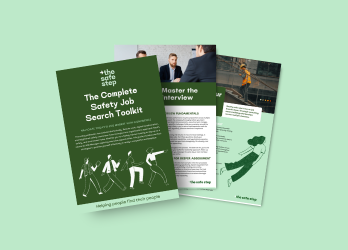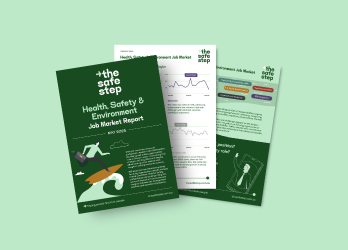Interview Success for Safety Professionals
Page Published Date:
September 1, 2025
You've just landed an interview for your ideal HSE role. Now comes the challenge: how do you distil years of impact, expertise and capability into just a few high-pressure conversations?
We see this all the time at The Safe Step. Highly capable HSE professionals—often with decades of experience - go into job interviews and undersell themselves. Not because they lack substance, but because they haven't needed to talk about their work this way for years. Interview success isn't about rehearsing perfect answers. It's about clearly communicating your value, showing how you think, and linking your experience to what matters most in the role.

The Foundation of Interview Success
"Tell me about your career background" might seem like an easy opener. Yet this question derails more safety professionals than any other.
"The biggest mistake I see is safety professionals treating that opening question like an invitation to recite their CV," explains experience HSE recruiter Suzi Johnson. "Five minutes in, the interviewer's eyes have glazed over and they've missed their chance to make a real connection."
The solution lies in strategic structure. Rather than chronologically rehashing your resume, create a compelling narrative that positions your experience against their specific needs. Your interviewer already has your CV—they don't need you to repeat it line by line.
Structure Your Story with the Rule of Three
Whether you have 5 or 30 years’ experience, structure your career story into three phases:
- Foundation (20%
"My early career gave me foundational experience in risk assessment, compliance management and team leadership, across various sectors." - Development (30%)
"I progressed into senior HSE roles where I gained exposure to C-suite stakeholders and led significant projects during periods of organisational change." - Current &/or Strategic (50%)
"Most recently, I’ve focused on enterprise-wide safety transformation, reporting to executives and shaping culture across teams.”
This approach demonstrates clear progression, acknowledges organisational challenges, and positions you as someone who understands both operational and strategic requirements.
The rule of three framework can be used throughout your job search – from resume writing to networking.
Mastering the STAR Method
When answering behavioural questions, many safety professionals fall into the trap of listing responsibilities rather than demonstrating impact. That’s where the STAR method comes in—Situation, Task, Action, Result—a simple structure that helps you communicate clearly, confidently, and with purpose.
Even if the question isn’t asked in STAR format, using it helps you focus your response and deliver what hiring managers really want to hear.
Here’s a strong STAR example:
- Situation: “When I joined the organisation, they were facing a 15% increase in recordable incidents year-on-year.”
- Task: “My objective was to stabilise incident rates, identify underlying behavioural drivers, and rebuild confidence in the safety program.”
- Action: “I introduced a behaviour-based safety program, set up cross-functional safety committees, and rolled out real-time incident reporting.”
- Result: “Within 18 months, we reduced incidents by 40% and secured our largest contract renewal—specifically citing improved safety performance as a key factor.”
This method helps you quantify the challenge, define your role, and link your actions to tangible outcomes—especially those that matter at a business level.
"Even if a question isn't asked in STAR format, an efficiently delivered response using Situation, Action, Results is gold," notes Suzi Johnson.
Speaking Strategically, Not Just Technically
In modern safety roles, compliance is the baseline - not the destination. Employers are looking for leaders who understand how safety fits within the broader commercial landscape.
- Instead of saying: "I ensured compliance with all relevant safety regulations"
- Say: "I developed a compliance framework that met all requirements while cutting admin time by 30%, which allowed our team to shift focus to proactive risk work and stakeholder engagement.”
This demonstrates resourcefulness, impact, and business awareness.
Technical Competency Questions
While behavioural questions assess cultural fit and leadership potential, technical questions evaluate your professional competence. Safety interviews often include scenario-based challenges that test your practical knowledge and decision-making approach.
Be prepared to discuss incident investigation methodology, risk assessment frameworks, change management processes, stakeholder management during regulatory situations, and integration of safety systems with broader business operations. The key is demonstrating your technical expertise while highlighting your ability to communicate complex concepts to non-technical stakeholders.
Understanding the Interview Process
Senior safety roles typically involve 2-3 interview rounds, often more if you're reporting to the CEO and there's board involvement.
Take a strategic approach by tailoring your responses as you meet with increasingly senior stakeholders—early rounds focus on demonstrating competence and cultural fit, while later stages require you to articulate your vision and connect safety outcomes to broader business objectives.
Don't forget, an interview is a two-way street with your opportunity to not only sell yourself but assess fit. "A well-run interview process tells you a lot about how the company operates—and whether you want to work there," notes Suzi Johnson.
Avoid Common Pitfalls
Even experienced professionals can lose momentum if they fall into these traps:
- Giving long-winded responses that drift or lack direction
- Focusing too much on technical detail without broader impact
- Not researching the company’s safety goals or recent challenges
- Speaking negatively about past roles or teams
- Failing to prepare meaningful questions that show curiosity and strategic interest
Good luck!
Interview success isn't about perfect answers—it's about demonstrating your thought process and showing how you collaborate with stakeholders at all levels. The best approach is to be authentic—the right opportunity will value what you bring.
When working with The Safe Step, our consultants provide practical interview coaching and specific insights into what individual hiring managers prioritise, giving you the confidence to perform at your best.




